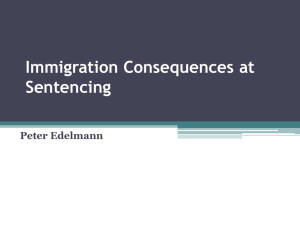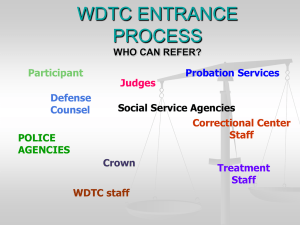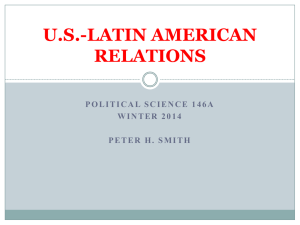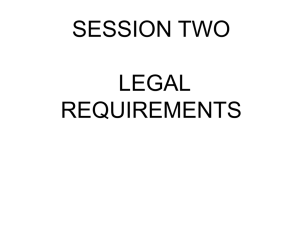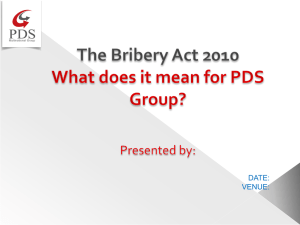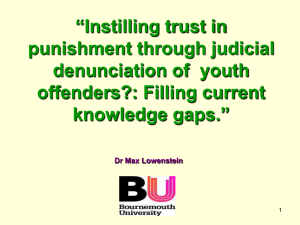Complicity
advertisement
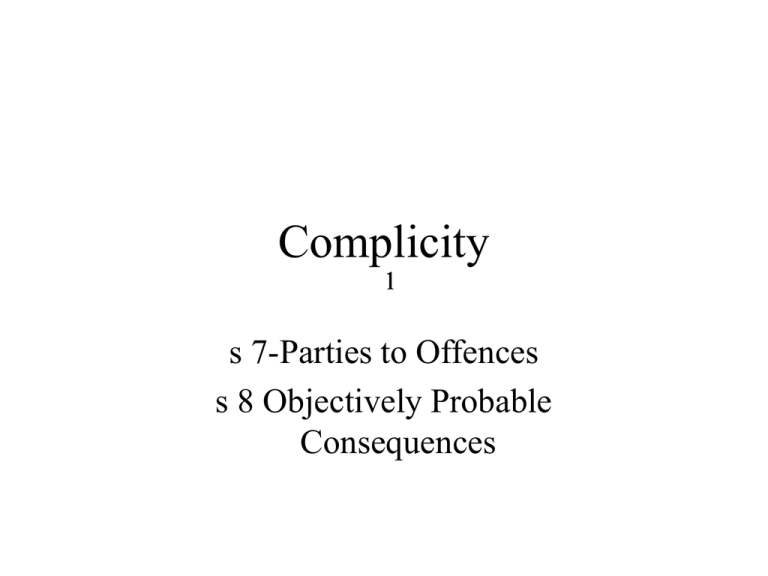
Complicity 1 s 7-Parties to Offences s 8 Objectively Probable Consequences Complicity cont • Complicity provisions apply to all offences in Qld-s 2 Criminal Code Act 1899 2 • s7 Criminal Code-Parties to Offences – s 7(1)(a)- The Person who executes the offence • by either act or omission – Persons acting pursuant to Common Unnlawful Purposes-Wyles – s 7 (1)(b)-The Enabler • enable or aid TO commit the offence Complicity cont – enabler need not be actually present • eg Jervis; Borg; Johnson – At common law called Accessories before the fact • s 7(1) (c)-The aider 3 – aids IN commiting the offence • usually present at commission of offence – mere presence insufficient • must be intentional or wilful encouragement • encouragement must actually support-Beck Complicity cont • s 286 Criminal Code-duty wrt child: to take precautions to avoid danger and remove from danger c/f Russell 4 Procurer – s 7(1)(d)-Counsellor or • counsel- “advise or recommend” • procure- “to cause or bring about”-Oberbillig – innocent agents-fourth proviso • Offences different to that counselled – ie counselling to commit SOME offence – and person counselled commits THE offence Complicity cont • combination of s 7 (1) (d) and s 9 – Nichols Johnson and Aicheson: counsellor guilty if: 5 • offence committed was counselled-but no way of committing was counselled-s 7(1) (d) • different offence committed to that counselled but facts constituting the offence actually committed are A PROBABLE CONSEQUENCE of the counselling-s 7(1) (d) and s 9 Complicity cont • The offence counselled was committed and was committed in way counselled -s 7(1)(d) • The offence committed was counselled but was 6 counselled and the facts committed in a way not constituting the offence actually committed ARE A PROBABLE CONSEQUENCE of carrying out the counsel-s 7(1)(d) and s 9 – eg Stuart-counselled arson but committed murder Complicity cont • S 7-offence must be committed before provisions apply – but actual offender need 7 not be prosecutedLopusszynski – aider or enabler commiting different offences • s 10A (1) Criminal Code Complicity cont • Knowledge required by aider and enabler under ss (b) and (c) – ss (b) “for the purpose 8 of enabling..”-must know the what offence IS OR MIGHT be committed-Jervis – knowingly aid: Beck – ss © “aids” ? – must know what offence is OR MIGHT be committed-Jervis approving Solomon; Complicity cont – Relevance of Common Law? • Wyles ; Johns – intentional participation 9 and knowledge of essential facts that constitute the offenceGiorgianni; Beck; – Jeffrey Pascoe and Donald – R v Lowrie and Ross • Doctrine of Common purpose at common law- • Extension of Giorgianni? – McAuliff 10 • THUS MUST ASCERTAIN SUBJECTIVELY THE COMMON PLAN OR ENTERPRISE Complicity cont – measured by KNOWLEDGE OR FORSIGHT of participants- Jervis ;Brennan – Things NECESSARILY 11 IN CONTEMPLATION-Johns – Includes things FORESEEN though NOT agreed to-McAuliff – Must know ESSENTIAL FACTS constituting offence Complicity cont • “Merely unexpected incidents”?-if subjectively within the plan-Varley; Markby; Dang 12 • DYNAMIC CHANGES WITHIN PLAN – Johns; Miller; Beck; Jeffrey Pascoe and Donald • WITHDRAWL FROM PLAN? – Menniti Complicity cont • Dual tests of White v Ridley • Acts of withdrawal must be capable of being effective PLUS accompanied by such reasonable 13 previous participationaction as can take to undo Thomas J applying Gibbs CJ • necessary to actually cancel previous participation such that if offence committed is by intervention of new cause-Stephen and Aickin JJ-Derrington J Complicity cont • COMMON UNLAWFUL PURPOSES AND OBJECTIVE CONSEQUENCES-S 8 Criminal Code 14 – offences beyond scope of common plan • ie NOT contemplated, foreseen by accused or merely unexpected incidents – s 8 may extend criminal responsibility nevertheless Complicity cont • “Common Intention” to prosecute an unlawful purpose – subjectively ascertained 15 ‘state of mind’ • ascertained in same way as with s 7: Brennan; Stuart; Jervis • includes any reasonable inferences drawn from circumstances-Johns – “Offence committed OF SUCH A NATURE that its commission was A PROBABLE CONSEQUENCE Complicity cont • Objectively ascertained • “Forseeability of Average Person”-Stark J in Brennan 16 person in accused’s • “Apparent to ordinary position”-Jacobs J in Stuart • “A real possibility”- Fitzgerald P in Hinds and Harwood • “A substantial or real chance”-Pincus JA in Hinds and Harwood Complicity cont • DEEMED TO HAVE COMMITTED ‘THE OFFENCE’ – S 10A(2) Criminal responsibility extends to 17 ANY offence that on the evidence IS A PROBABLE CONSEQUENCE of the prosecution of the common plan – Barlow v R: • “Offence” refers to an act done or omission made that renders liable to punishment Complicity cont – ‘secondary offender’ DEEMED to have done the act (or omission) of the principal offender 18 – ‘secondary offender’ NOT liable to same extent as principal offender • Offence of SUCH A NATURE – secondary offender deemed only to the extent that act done (or omission made) Complicity cont – in such circumstances OR – with such a result OR – with such a state of mind 19 • as was a probable consequence of prosecuting the common unlawful purpose Complicity cont – DUAL RELEVANCE OF STATE OF MIND OF SECONARY OFFENDER • Firstly: to determine the content of the common 20 intention to prosecute the unlawful purpose – THEN S 8 DEEMS THE SECONDARY OFFENDER TO HAVE DONE THE ACT OF THE PRINCIPAL OFFENDER in so far as that act or omission is of a nature covered by the common intention Complicity cont • Secondly: At the time when the act of the Principal offender is done. If at that time the secondary offender had a state of mind WHICH IN COMBINATION21 WITH THE DEEMED ACT renders the secondary offender guilty of A MORE SERIOUS OFFENCE than that which the principal offender committs, the secondary offender is liable to conviction for the more serious offence Complicity cont • ‘IN THE PROSECUTION OF’ – in the furtherance of -Phillips and Lawrence; Hinds and Harwood;22 • WITHDRAWL FROM COMMON UNLAWFUL PURPOSE – Show DISASSOCIATION distinctly by an UNEQUIVOCAL and TIMELY communication-Saylor; Minetti R v Jervis • Common Unlawful Purpose – Common intention to effect unlawful purpose of killing or causing gbh • Objectively Probable Consequences 23 – Objectively probable consequence of killingie ‘a real possibility’ or ‘substantial or real chance’ -Murder R v Jervis • Common Unlawful Purpose – a common intention to effect the unlawful purpose of wounding to take blood • Objectively Probable Consequences 24 – objectively probable consequence of intentional killing 302(1)(a) by intending to cause gbh-Murder – -----------------------OR objectively probable consequence of dangerous act killing under 302(1) (b)Murder R v Jervis • Common Unlawful Purpose – a common intention to effect the unlawful purpose of wounding or causing some other injury or hurt falling short of death or gbh • Objectively Probable Consequences 25 – an objectively probable consequence of dangerous act killing 302(1)(b)-Murder – -----------------------OR an objectively probable consequence of unintentional killing-Manslaughter
